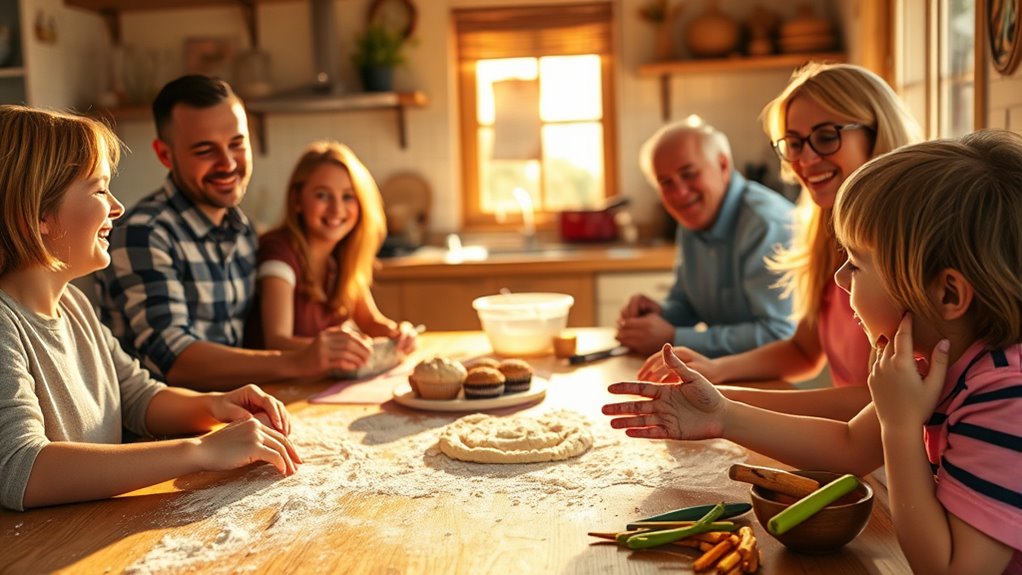Creating family rituals and traditions can really strengthen your family’s bond and transform everyday moments into cherished memories. Start with fun activities everyone enjoys, like weekly movie nights or monthly game nights. Incorporate seasonal celebrations, letting each family member add personal touches. Share stories during dinners to connect with your roots. Embrace change as traditions evolve, and document these experiences to revisit later. If you want to explore deeper ways to craft your family identity, there’s more to discover.
Key Takeaways
- Identify joyful activities that all family members enjoy, such as game nights or movie nights, to strengthen connections and create shared experiences.
- Incorporate seasonal celebrations by decorating together, allowing personal contributions, and cultivating excitement for festivities that build family identity.
- Emphasize the power of storytelling by sharing family history and childhood stories during family gatherings to strengthen emotional bonds and core values.
- Embrace flexibility in traditions, allowing new rituals to emerge while documenting experiences through photos or journals for future reflection.
- Foster a sense of ownership by involving all family members in creating and maintaining rituals, ensuring they resonate with everyone’s interests and values.

Creating family rituals and traditions can strengthen bonds and create lasting memories, so it’s worth taking the time to establish them. When you make the effort to create shared experiences, you’re not just filling your calendar; you’re building a foundation for connection. Think about how even the simplest traditions can transform ordinary days into special occasions that your family looks forward to year after year.
Start by identifying activities that bring joy to everyone involved. It could be a weekly movie night where you all snuggle up with popcorn, or perhaps a monthly family game night where competitiveness brings out laughter and friendly banter. You’ll find that these moments foster connection and give everyone something to look forward to, making your family feel more cohesive.
Identifying joyful activities, like movie nights or game nights, fosters connection and creates cherished moments for your family.
Incorporating seasonal celebrations can also enhance your family’s sense of togetherness. You might begin a tradition of decorating the house for holidays together, allowing each member to contribute their unique touch. This not only creates excitement but also cultivates a sense of ownership and pride in your family’s traditions. Year after year, these shared experiences will become cherished memories that your family can reminisce about for generations.
Don’t underestimate the power of storytelling, either. Consider setting aside time to share stories from your own childhood or family history. This can be done during dinner or while gathered around a fire pit. By sharing these narratives, you’ll help your family connect with their roots and understand the values that shape your family identity.
As you establish rituals, be flexible and open to change. What works for your family now might evolve over time, and that’s perfectly okay. You may find that one tradition fades while another emerges—embrace this fluidity. This adaptability will keep your rituals fresh and relevant, ensuring they resonate with everyone involved.
Finally, make sure to document these experiences. Whether through photos, a family journal, or even a shared online album, capturing these moments will allow you to revisit the joy and laughter long after the day has passed. This not only strengthens bonds but also creates a legacy for future generations. Additionally, consider seeking professional counseling to help navigate any emotional challenges during the establishment of these traditions.
In the end, creating family rituals and traditions requires intention and effort, but the rewards are immeasurable. So gather your loved ones, start brainstorming, and let the magic of shared experiences bring your family closer together.
Frequently Asked Questions
How Do I Involve Older Children in Family Rituals?
Involving older children in family rituals is all about making them feel included and valued. Start by asking for their input on activities, like planning game nights or themed dinners. Let them lead some aspects, whether it’s picking the movie or setting up the space. You could also create special roles for them, like a “family historian” who documents the events. This way, they’ll feel a sense of ownership and connection to the traditions.
What if Family Members Disagree on Traditions?
If family members disagree on traditions, it’s important to communicate openly. Encourage everyone to share their feelings and reasons behind their preferences. You can suggest a compromise or rotate traditions each year, so everyone feels included. Emphasize the value of family connection over specific customs. Sometimes, creating new traditions that blend different ideas can help unite everyone. Remember, the goal is to strengthen bonds, not to create conflict.
Can Rituals Be Adapted for Blended Families?
Absolutely, you can adapt rituals for blended families! Start by discussing everyone’s preferences and ideas. Incorporate elements from both sides to create new traditions that honor everyone involved. Be flexible and open to change; this helps build connections and fosters a sense of belonging. As you celebrate together, you’ll find unique ways to blend your family’s history, making the experience even richer and more meaningful for everyone.
How Do I Keep Traditions Exciting Over Time?
To keep traditions exciting over time, think of them as a garden; you need to nurture them to bloom. You can spice things up by adding new elements, like themes or activities, while keeping the core intact. Invite everyone’s ideas, making them feel invested. Rotate responsibilities so everyone has a role. And don’t be afraid to break the mold occasionally—surprise your family with unexpected twists that breathe fresh life into your cherished customs!
Are There Rituals Specific to Different Cultures?
Yes, there are many rituals specific to different cultures. Each culture has unique traditions that reflect its values, beliefs, and history. For instance, you might celebrate Diwali with family by lighting lamps, or partake in a Chinese New Year reunion dinner. These rituals often involve specific foods, ceremonies, or festivities that can deepen your connection to your heritage. Exploring these can enrich your understanding and appreciation of diverse cultural practices.
Conclusion
As you gather around the table for your family’s weekly game night, remember that these small moments weave the fabric of your family’s story. Just like a quilt, each shared laugh and inside joke adds a vibrant patch to the tapestry of your lives together. Research shows families with strong traditions report higher happiness levels, reminding us that these rituals aren’t just routines; they’re the heartbeats of your family, creating lasting bonds that warm your home.









